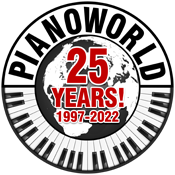 |
Welcome to the Piano World Piano Forums
Over 3 million posts about pianos, digital pianos, and all types of keyboard instruments.
Over 100,000 members from around the world.
Join the World's Largest Community of Piano Lovers
(it's free)
It's Fun to Play the Piano ... Please Pass It On!
|
|
|
|
36 members (accordeur, danno858, David Boyce, 8ude, David B, Dave Horne, 7 invisible),
1,445
guests, and
92
robots. |
|
Key:
Admin,
Global Mod,
Mod
|
|
|
|
Joined: Jan 2017
Posts: 2,187
2000 Post Club Member
|
OP

2000 Post Club Member
Joined: Jan 2017
Posts: 2,187 |
Here are some ideas I have on the topic. I've been reading some books on piano recently, and surprisingly enough many famous pianists advocate several of these, while many teachers seem to avoid some of them.
1. Play slowly and methodically.
2. Play fast, allow there to be gaps in your playing but experience the speed. The gaps will resolve themselves through slow practice. Allow it to be approximate at the start.
3. Listen to fast piano playing, and emulate it. The aural image of what needs to be produced assists in developing digital dexterity.
4. Playing fast is often a matter of unlocking the capacity of the mind to play fast. For this the individual player needs to do what is necessary, because everyone's mind is different. It is necessary to gain a mental representation of the sensation of playing fast.
5. If you have one hand which can play certain things fast, mimic the sensations produced in that hand with the opposite hand.
6. Identify roadblocks to speed such as thumb crossings, and drill them individually. Experiment with different possibilities of the finger, wrist and arm. Strive to always keep the arm, wrist and fingers in alignment. Release tension in the arm and wrist except to the extent necessary.
In my experience, I have experienced several of these. I would listen to very fast piano playing (Cziffra and Volodos transcriptions, Art Tatum and the like) until I could hear all of the notes. I would try to speed up often, or try to go along with a certain aural image I had. I have also done slow, methodical practice -- however, the fact that everyone seems to do this, but very few seem to attain a high level of speed makes me think that for most people, the other parts of the equation are the more important (and sadly, highly under-emphasized) ones.
Last edited by ranjit; 07/30/23 04:18 PM.
|
|
|
|
|
Joined: Feb 2015
Posts: 4,260
4000 Post Club Member
|

4000 Post Club Member
Joined: Feb 2015
Posts: 4,260 |
Ranjit why are you so obsessed with playing fast? There are so many other skills that are equally important.
If you were taught properly then speed just develops naturally over time. What I found a comfortable tempo 2 years ago seems tediously slow now and what seemed impossible is pretty normal now. I haven't really done much to push my tempo and it still happened even without me obsessing over it.
|
|
|
|
|
Joined: Jul 2017
Posts: 2,598
2000 Post Club Member
|

2000 Post Club Member
Joined: Jul 2017
Posts: 2,598 |
Whilst there is a lot of overcomplex information about playing a passage faster, and it depends on the passage, in general i think it is simple. I think the most successful method to build up tempo is to practice difficult passages (assuming it is a run of fast notes, e.g. semiquavers) in to practice these in different rhythms. It is what my teacher suggested and it always works and I think more successful than just playing faster. Also yes, identify each particular problem part (you call a roadblock) to focus on them but this often needs a teacher to highlight this in a lesson.
|
|
|
|
|
Joined: Jan 2017
Posts: 2,187
2000 Post Club Member
|
OP

2000 Post Club Member
Joined: Jan 2017
Posts: 2,187 |
Ranjit why are you so obsessed with playing fast? Because no one seems to be discussing it, and it is a strength of mine.
|
|
|
|
|
Joined: Aug 2021
Posts: 1,524
1000 Post Club Member
|

1000 Post Club Member
Joined: Aug 2021
Posts: 1,524 |
Slowly I've come around to this way of thinking. Forum member johnstaf said he practices at different tempos. Another player, a Reddit user who, based on the user's posting history, seems to know what s/he is talking about, says there's something to be gained from both very slow and fast practice (important caveat: fast practice after a lot of slow practice). I'm talking about passages with many connected notes. S/he said you find things out about the movement and positioning of the hand in fast practice you won't discover during slow practice (fast here = faster than the specified tempo). Also, playing fast forces the player to make more-efficient motions, especially with the fingers. That said, virtually everyone agrees slow practice with a metronome is best for beginners, followed by gradual increases in tempo up to the designated tempo.
Both very soft and semi-loud playing are also helpful. When playing softly, if one pays attention to the feeling of the fingertips on the keys, this will provide information on how well-balanced the hand is at any given moment as it moves across the keys.
What the OP said about trying to always keep the arm, wrist and fingers in alignment I also think is helpful, not only on top but also along the outer edge of the forearm, wrist, and hand. Obviously, it isn't practical for the outer edge of all three to be in alignment at all times, or even most of the time; however, developing a feeling of making the outer edge line up whenever the player gets the chance is helpful. A feeling of them always "wanting" to line up. It helps develop consistency and accuracy (very noticeably when making big jumps across the keyboard).
Seiler SE-186
|
|
|
|
|
Joined: Oct 2010
Posts: 18,085
10K Post Club Member
|

10K Post Club Member
Joined: Oct 2010
Posts: 18,085 |
You can play fast when you can play fast. And in control.
Any Tom, Dick or Harriet can play fast and totally out of control, inaccurately, rubbishly, like a patzer or duffer (to borrow terms from the chess world).
Develop your chops (not lamb chops) with the right technical training, learn and practice a wide variety of music, cogitate and ruminate over time, and……….voila!
The fastest way to play fast is one every beginner can do - a glissando 🤪🫠🤥🤯. All the right notes in the right order, as Andre Preview wouldn’t say…….
If music be the food of love, play on!
|
|
|
|
|
Joined: Sep 2017
Posts: 4,546
4000 Post Club Member
|

4000 Post Club Member
Joined: Sep 2017
Posts: 4,546 |
Partly due to efficient fingerings. Some awkward fingerings may slow you down. Lighten your touch so you can move from key to key quicker. Once you pressed a key, it'd not take as much effort to keep it down so you can start releasing your touch sooner. [video:youtube] https://www.youtube.com/shorts/r1ihL7l4QpE[/video] Playing with the least amount of effort would help you speed up your notes.
|
|
|
|
|
Joined: Sep 2014
Posts: 5,545
5000 Post Club Member
|

5000 Post Club Member
Joined: Sep 2014
Posts: 5,545 |
Rapid virtuoso playing is definitely a topic for discussion and research, as did Ferruccio Busoni, the most outstanding virtuoso of the early 20th century, in his time. He developed a method of technical phrasing described in Grigory Kogan's book A Pianist's Work. G.K. also described her in other book Busoni as a pianist, but for some reason the translator left out this part. Snippet here: https://books.google.co.il/books?id...%20of%20technical%20phrasing&f=false - page123 Busoni's technical phrasing method: By technical phrasing, Busoni understands “the decomposition of a passage into groups depending on: a) musical motives; b) positions of notes on the keyboard; c) change of direction of movement.
|
|
|
|
|
Joined: Feb 2021
Posts: 586
500 Post Club Member
|

500 Post Club Member
Joined: Feb 2021
Posts: 586 |
Yeah it's good tips what you say. I've done mostly all of them.
It's much simpler though.
Ask yourself a few questions.
Do you touch the bottom of the key for every note, and fully release at everytime.
Try to play with only the top joint of your fingertip, I was talking to a prof who was a student of Adele Marcus and his technique was really great. He said that your smallest muscles move the fastest, so abuse that on the piano (he proceeded to say your eyelids are the smallest and blinked very rapidly).
Then the most important is the work aspect.
Have you done all your scales, and are they all equally comfortable, basic arpeggios and their inversions, 7th chord arpeggios, scales in thirds/sixths, chromatic thirds, also played a considerable amount of Bach WTC (preludes specifically, especially the ones that are recommended by Heinrich Neuhaus), also the first 5 Hanon exercises mastered and transposed, and a good amount of Czerny especially op 299 first 10 studies.
This is all you need I believe, and doing more technically work should be overkill, and you can get anything you need from pieces after doing all this stuff. I'm working towards this, and am putting a good dent, but, really playing fast just comes with time, and comes from exercises, and patience.
favorite pianists: Cortot, Taneyev, Pabst, Michalowski, Pugno, Lhevinne, Hofmann, Busoni,
favorite tenors: Caruso, Bonci, Anselmi, LV
favorite soprano: Callas
favorite basses: Plancon, Chaliapin, Pinza,
favorite baritones: Battistini,Granforte
favorite conductors: Walter, Toscanini, Fried, Coates,
|
|
|
|
|
Joined: Mar 2006
Posts: 16,328
10K Post Club Member
|

10K Post Club Member
Joined: Mar 2006
Posts: 16,328 |
This thread reminds me of the lyrics to one of my original blues songs entitled "I like fast boogie-woogie". Some of the lyrics are "I like fast boogie-woogie and hard-driving rock-n-roll too. And when I try to play it slow, you know it's such a hard thing to do". (sorry I couldn't resist  ) Also, it seems I have two tempos when playing the piano... fast and faster. Guess I'm just hyper active  Nice to hear from you ranjit! Rick
Piano enthusiast and amateur musician: "Treat others the way you would like to be treated". Yamaha C7. YouTube Channel
|
|
|
|
|
Joined: Dec 2010
Posts: 3,549
PW Gold Subscriber 3000 Post Club Member
|

PW Gold Subscriber 3000 Post Club Member
Joined: Dec 2010
Posts: 3,549 |
Here are some ideas I have on the topic. I've been reading some books on piano recently, and surprisingly enough many famous pianists advocate several of these, while many teachers seem to avoid some of them.
1. Play slowly and methodically.
2. Play fast, allow there to be gaps in your playing but experience the speed. The gaps will resolve themselves through slow practice. Allow it to be approximate at the start.
3. Listen to fast piano playing, and emulate it. The aural image of what needs to be produced assists in developing digital dexterity.
4. Playing fast is often a matter of unlocking the capacity of the mind to play fast. For this the individual player needs to do what is necessary, because everyone's mind is different. It is necessary to gain a mental representation of the sensation of playing fast.
5. If you have one hand which can play certain things fast, mimic the sensations produced in that hand with the opposite hand.
6. Identify roadblocks to speed such as thumb crossings, and drill them individually. Experiment with different possibilities of the finger, wrist and arm. Strive to always keep the arm, wrist and fingers in alignment. Release tension in the arm and wrist except to the extent necessary. These points have been made before, likely in the books and videos you've been reading/watching. It would be nice if you gave some attribution so that others could dig deeper.
![[Linked Image]](https://forum.pianoworld.com//gallery/42/medium/21193.png) Yamaha C3X
|
|
|
|
|
Joined: Mar 2010
Posts: 1,044
1000 Post Club Member
|

1000 Post Club Member
Joined: Mar 2010
Posts: 1,044 |
Here are some ideas I have on the topic. I've been reading some books on piano recently, and surprisingly enough many famous pianists advocate several of these, while many teachers seem to avoid some of them.
1. Play slowly and methodically.
2. Play fast, allow there to be gaps in your playing but experience the speed. The gaps will resolve themselves through slow practice. Allow it to be approximate at the start.
3. Listen to fast piano playing, and emulate it. The aural image of what needs to be produced assists in developing digital dexterity.
4. Playing fast is often a matter of unlocking the capacity of the mind to play fast. For this the individual player needs to do what is necessary, because everyone's mind is different. It is necessary to gain a mental representation of the sensation of playing fast.
5. If you have one hand which can play certain things fast, mimic the sensations produced in that hand with the opposite hand.
6. Identify roadblocks to speed such as thumb crossings, and drill them individually. Experiment with different possibilities of the finger, wrist and arm. Strive to always keep the arm, wrist and fingers in alignment. Release tension in the arm and wrist except to the extent necessary.
In my experience, I have experienced several of these. I would listen to very fast piano playing (Cziffra and Volodos transcriptions, Art Tatum and the like) until I could hear all of the notes. I would try to speed up often, or try to go along with a certain aural image I had. I have also done slow, methodical practice -- however, the fact that everyone seems to do this, but very few seem to attain a high level of speed makes me think that for most people, the other parts of the equation are the more important (and sadly, highly under-emphasized) ones. Some people literally can't think that fast. If fast is the only goal, you'll never obtain it with a beautiful sound. It's not always "fast" either. Sometimes it's brilliant, sometimes is colorful, sometimes it's a wash - all these effects are different, but they never started by being "fast". Nothing in music is black and white. You nailed it with slow and steady.
|
|
|
|
Forums43
Topics228,457
Posts3,405,495
Members114,972
| |
Most Online15,252
Mar 21st, 2010
|
|
|
|
|
|
|







![[Linked Image]](https://forum.pianoworld.com//gallery/42/medium/21193.png)